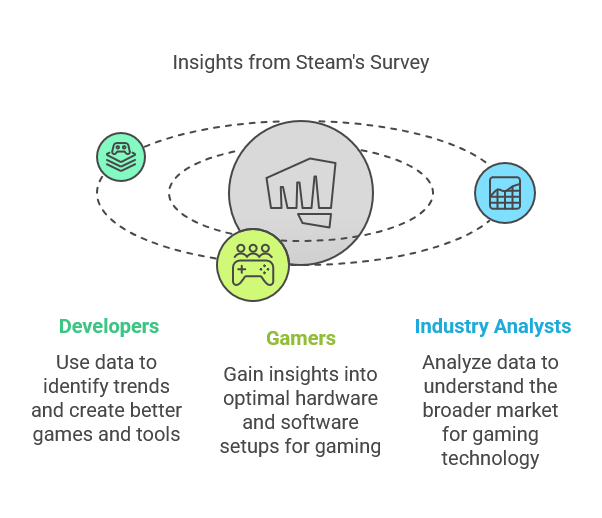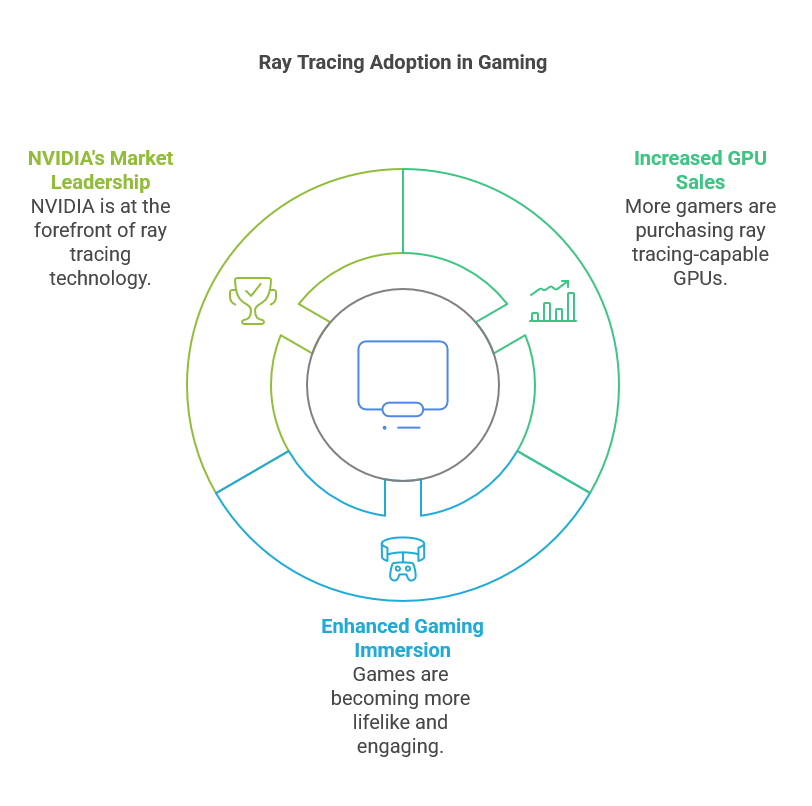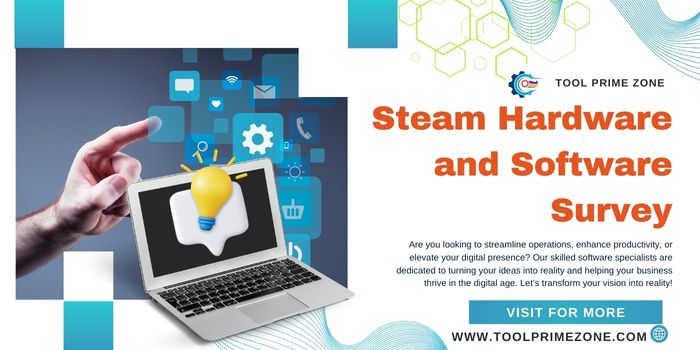Steam Hardware and Software Survey is crucial for understanding gaming trends. As the world’s largest digital distribution platform for video games, Steam regularly surveys hardware and software usage among its vast user base. These surveys reveal vital information about millions of gamers’ gaming preferences and setups worldwide. Understanding these trends provides insights into the future of gaming technology and helps gamers and developers make informed decisions.
The Steam Hardware and Software Survey examines gamers’ latest tech and software preferences. This article will analyze the most recent survey data and explain what it means for the gaming world in 2025.
The Importance of Steam’s Survey
Steam’s Hardware and Software Survey is significant because it collects monthly data from millions of gamers. This data provides a comprehensive view of the type of hardware and software that gamers are using. Whether it’s for gaming PCs, operating systems, or graphics cards, these insights help developers design better products and improve user experiences.
Steam’s Survey Data Can Help:
- Developers: Identify trends and preferences to create better games and tools.
- Gamers: Find out what hardware and software setups work best for their gaming experience.
- Industry Analysts: Understand the broader market for gaming-related technology.

What Does the Steam Hardware and Software Survey Show in 2025?
The 2025 Steam Hardware and Software Survey highlights several notable trends in the gaming industry. Let’s dive into the details of the most crucial findings.
1. The Shift Towards More Powerful Gaming PCs
Over the years, gaming PC specifications have continued to improve. According to the latest Steam survey, there has been a noticeable increase in gamers using powerful hardware. This includes high-end processors, graphics cards, and gaming monitors with better refresh rates. The push towards higher performance responds to the increasing demand for graphically intensive games, virtual reality (VR), and 4K gaming.
Key Findings:
- The percentage of users with multi-core processors has increased significantly, with Intel Core i7 and AMD Ryzen 7 being the most popular choices.
- High-end GPUs like the NVIDIA RTX 3000 and 4000 series are leading the market, with a growing number of gamers opting for these cutting-edge graphics cards for smoother performance and enhanced graphics quality.
- VR gaming continues growing, and more gamers opt for high-performance headsets.
2. Operating Systems: Windows Dominates, but Linux Is Gaining Ground
Operating systems: Windows continues to dominate the Steam user base. However, Linux has seen a steady increase in adoption. Steam’s efforts to support Linux gaming through SteamOS have resulted in a growing number of Linux users. This trend shows that more gamers are exploring alternatives to Windows, driven by the flexibility and open-source nature of Linux.
Key Findings:
- Windows 10 and 11 remain the most popular operating systems, with Windows 10 taking the lead.
- SteamOS has slowly gained traction thanks to initiatives like the Steam Deck, which runs on SteamOS and encourages Linux adoption.
- Gamers seeking high performance in speed and stability are increasingly turning to Linux for gaming.
3. Graphics Cards: The Rise of Ray Tracing Technology
Ray tracing, a rendering technique that produces realistic lighting effects, is becoming increasingly popular in gaming. The latest survey shows that more and more gamers are investing in GPUs that support ray tracing, such as the NVIDIA RTX 3000 and 4000 series.
Ray tracing offers photorealistic lighting effects, making games look much more immersive. Titles like Cyberpunk 2077 and Control have demonstrated the potential of ray tracing, which has led to increased adoption of compatible hardware.
Key Findings:
- Ray tracing-enabled GPUs are gaining popularity, with NVIDIA leading the charge in this area.
- The demand for high-quality, high-frame-rate gaming experiences has led to more gamers upgrading to newer graphics card models.

4. Gaming Peripherals: The Growing Demand for High-End Gear
Regarding peripherals, the Steam Hardware and Software Survey reveals an increasing trend toward high-end gaming gear, including mechanical keyboards, gaming mice with high DPI, and premium gaming headsets. The increased focus on competitive gaming, especially esports, has made high-quality peripherals more critical.
Key Findings:
- Mechanical keyboards are preferred by a large portion of the gaming community for their tactile feel and speed.
- Gaming mice with adjustable DPI (dots per inch) are more common, providing gamers with the precision they need for competitive play.
- High-quality gaming headsets with surround sound and noise-canceling features are gaining popularity as immersive audio is a critical part of the gaming experience.
5. Virtual Reality (VR) and Augmented Reality (AR) Gaming
The Steam survey reveals an increase in the adoption of VR headsets among gamers. While VR is still in its early stages of widespread adoption, the Steam survey data indicates that VR gaming is growing in popularity, especially with the release of more affordable and accessible VR headsets.
Key Findings:
- VR headsets like the Oculus Quest and Valve Index are becoming more popular.
- Games designed for VR are improving in terms of interaction and immersion, making the experience more appealing.
- AR games are still in the early stages, but developers are exploring the technology for future gaming experiences.
6. Gamepad and Controller Preferences
Gamepad usage among Steam users has been growing steadily. More gamers are switching to gamepads over traditional mouse-and-keyboard setups, especially for console-style games and specific genres like action or adventure games.
Key Findings:
- Xbox controllers continue to dominate as the top choice among Steam gamers.
- The popularity of PlayStation controllers is also increasing, thanks to their compatibility with Steam and the gaming community’s growing interest in cross-platform gaming experiences.
FAQs
Q1: How accurate is the Steam Hardware and Software Survey?
The survey is based on data from millions of active users, making it highly reliable for understanding general trends. However, it’s important to note that it may not represent every gamer, especially those who do not participate in the survey. While the sample size is large, non-participation by specific user groups may introduce some bias in the data.
Q2: Does the Steam Hardware and Software Survey include data on mobile gaming?
The Steam survey focuses primarily on PC gaming, including CPUs, GPUs, RAM, and operating systems. It does not provide detailed data on mobile gaming devices or trends in the mobile gaming market.
Q3: What impact does the Steam Survey have on developers?
Game developers can use the survey data to identify the most commonly used hardware and software among gamers. This helps them optimize their games for the most popular setups, ensuring better compatibility and improved performance across various systems.
Q4: Is the Steam Hardware and Software Survey updated regularly?
The survey is updated monthly, providing fresh data on gaming hardware and software preferences trends. This helps track evolving patterns and shifts in the gaming ecosystem over time.
Q5: How can I participate in the Steam Hardware and Software Survey?
To participate, you need to opt in through Steam’s settings. It’s anonymous, and your participation helps the broader gaming community understand hardware and software preferences, allowing developers to make informed decisions.
The Steam Hardware and Software Survey offers valuable insights into the gaming preferences of millions of gamers. The latest data from 2025 reveals a shift toward more powerful gaming PCs, the increasing popularity of ray tracing technology, and the steady rise of Linux gaming. Gamers invest more in high-quality peripherals like mechanical keyboards and gaming mice to improve their overall experience.
As gaming continues to evolve, so do the tools and technologies that support it. The Steam survey is a vital resource for developers, gamers, and industry analysts alike, providing key data that helps shape the future of gaming.

